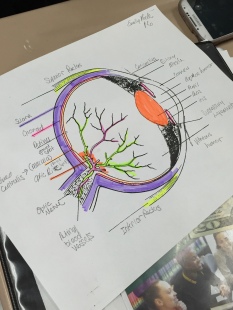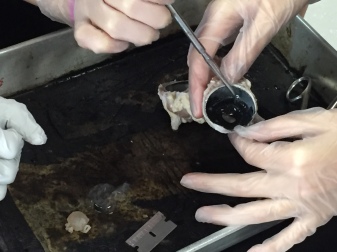I have been visiting many classrooms the past few weeks. Since I started with the science department, my next few posts will be about all science classes here at Hart! Paula Bae is up first… I emailed the science teachers on a Friday to let them know I would be coming in the following week and Paula emailed me right back to tell me she was running a lab that afternoon if I wanted to stop by. Before I get into the dissection details, let me first talk a bit about discovery learning.
Discovery Learning: A method of inquiry-based instruction encouraging students to use prior knowledge to make new meaning. The instructor asks prompting questions and provides feedback, but the learning is student-centered.
I mention discovery learning because it is the current shift we are seeing in education. Lectures and note-taking, followed by testing are not considered optimal learning activities. Do we need some lecture? Of course! Should students take notes? Ummmm…yes! But we also must design learning to become more student-focused. Teachers will provide students opportunities to make educated guesses, to test out their theories, and to discover how new material connects to prior knowledge. I don’t know about you, but “lesson designing” sounds much more creative and enjoyable than “lesson planning.” And, let me tell you, Paula is a lesson-designing diva! Just sit back and imagine being a student in her Human Anatomy class.
Paula’s students spent the previous day reading and discussing the various parts of the eye. The student notes colorfully detail the cornea, iris, pupil and other elements of the eye.

Paula could have concluded the learning at this point, rationalizing that they know all there is to know based on the pictures they diagramed, the reading material, and her lecture. She may have simply tested them and moved on. As we know, however, learning through textbooks and lectures is not as effective as learning through discussion and experience. Paula knows this, too, which is why the lesson-designing diva crafted this lab to give her students a hands-on experience with a cow’s eyeball. Yes, you heard that correctly. I am sure this will be a memorable science lesson for her students (I know I won’t soon forget it!).
Never did I imagine I would be writing about eyeball dissection, but here it goes! Paula was a sight for sore eyes in her white lab coat as she instructed her students to pull their hair back, grab goggles, gloves, and aprons and get the lab started. Students broke up into groups of four while I appreciated her well-chosen playlist…starting with “Eye of the Tiger” and “Blinded by Science.” (How fun is that?) Paula reminded the students of their goal–to discover what was learned the previous day. Students stood before their trays and looked right into the eye of the cow. Next to the eyeballs were probes, scissors, and a razor. Without batting an eye, some students jumped right in and gently poked the specimen to see how much give it had. Others opted to stand back and watch.
As they began to cut into the eye and separate it out, they talked about what they saw. “I think that’s the blind spot,” says one young woman. Another in the group isn’t so sure and asks Paula if it is, in fact, the blind spot. Paula designed this lesson so she is prepared for these moments, of course. Instead of answering yes or no, she directs them to their notes and then has them feel for the point where the retina attaches. The students realize the optic nerve is on the other side and let out an, “Oh yeah!” I just love these ah-ha moments prompted by the instructor! A good lesson design will consider student responses ahead of time, and possible teacher responses. Moments later, another group asked Paula about the blind spot. She pointed them to the now expert group to collaborate a bit. No need for the teacher to be the one with all the answers, students must also look to their peers to help discover new information.
 After students worked with their specimens, they felt confident they could identify the parts on their own and called Paula over to display their knowledge. I am sure you have heard that we learn 10% of what we read, 80% of what we experience, and 95% of what we teach. This added piece not only keeps her students accountable, but it also allows them to teach….a lesson designed for optimal (or optical?) learning.
After students worked with their specimens, they felt confident they could identify the parts on their own and called Paula over to display their knowledge. I am sure you have heard that we learn 10% of what we read, 80% of what we experience, and 95% of what we teach. This added piece not only keeps her students accountable, but it also allows them to teach….a lesson designed for optimal (or optical?) learning.
So now you know why I refer to Paula as the lesson-designing diva…our teacher of the year is nothing short of amazing.

Thank you, Paula for welcoming me in! I enjoyed the poky little eyeball lab 🙂 
Keep your eye out for more on science class happenings in the next week…





